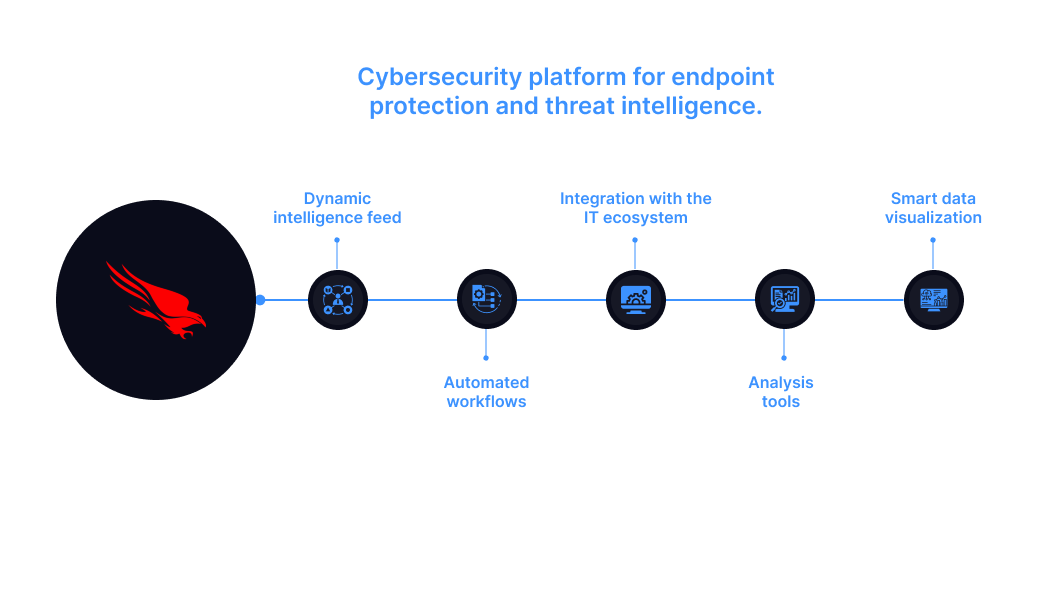CrowdStrike
Communication and Collaboration
CrowdStrike - Cybersecurity platform for endpoint protection and threat intelligence.

Detection Rules for CrowdStrike
These detection rules will focus on various aspects of Microsoft Teams such as chat activity, file sharing, meetings, and other collaboration features.
Provider: CrowdStrike
| Detection Rule | MITRE Tactic | MITRE Technique | Criticality | ||||||
|---|---|---|---|---|---|---|---|---|---|
| Malware Detected on Endpoint | Defense Evasion | T1036.004 - Masquerading | Critical | ||||||
|
|||||||||
| Privilege Escalation Attempt | Privilege Escalation | T1068 - Exploitation for Privilege Escalation | High | ||||||
|
|||||||||
| Suspicious PowerShell Command | Execution | T1059.001 - PowerShell | High | ||||||
|
|||||||||
| Unusual Network Connection | Command and Control | T1071 - Application Layer Protocol | Medium | ||||||
|
|||||||||
| Ransomware Encryption Activity | Impact | T1486 - Data Encrypted for Impact Web Protocols | Critical | ||||||
|
|||||||||
| Credential Dumping | Credential Access | T1003 - OS Credential Dumping | High | ||||||
|
|||||||||
| Remote Code Execution | Lateral Movement | T1210 - Exploitation of Remote Services | Critical | ||||||
|
|||||||||
| Endpoint Persistence via Registry Keys | Persistence | T1547.001 - Registry Run Keys/Startup Folder | Medium | ||||||
|
|||||||||
| Suspicious File Modification | Defense Evasion | T1070.004 - Indicator Removal on Host | Medium | ||||||
|
|||||||||
| Exfiltration of Sensitive Data | Exfiltration | T1048 - Exfiltration Over Alternative Protocol | High | ||||||
|
|||||||||
APIs and Their Scopes
| Detection / Hunting Rule | Required API | Scopes Required | Description |
|---|---|---|---|
| MFA Failure | GET /users/{userId}/login_history | user:read:admin | Retrieves user login history to identify MFA failures. |
| New Device Login | GET /users/{userId}/login_history | user:read:admin | Accesses login history to check for new device logins. |
| Unusual Geolocation Access | GET /users/{userId}/login_history | user:read:admin | Retrieves geolocation data for user logins. |
| Meeting Bombing Attempts | GET /report/meetings | meeting:read:admin | Accesses meeting report data to analyze participant activity. |
| Suspicious Meeting Links | GET /meetings/{meetingId} | meeting:read:admin | Retrieves meeting details, including chat logs and invites. |
| Data Leakage (Screen/File Sharing) | GET /report/meetings | meeting:read:admin | Retrieves meeting reports to check for screen/file sharing activities. |
| High Number of Participants | GET /report/meetings | meeting:read:admin | Accesses meeting participant lists to analyze spikes in attendance. |
| API Key Misuse | GET /users/{userId}/api_keys | user:read:admin | Retrieves API key usage details for the user. |
| Admin Account Changes | GET /users/{userId}/activity_logs | user:read:admin | Accesses admin activity logs for changes made by privileged accounts. |
| Configuration Drift | GET /accounts/{accountId}/settings | account:read:admin | Retrieves current security settings for the account. |
| Recording Retrieval | GET /meetings/{meetingId}/recordings | recording:read:admin | Accesses recordings for specific meetings. |
| Unusual Meeting Time Activity | GET /report/meetings | meeting:read:admin | Retrieves meeting logs to identify unusual activity patterns. |
| Anomalous File Transfer | GET /report/meetings | meeting:read:admin | Accesses meeting reports to check for file transfers. |
| External Participant Spike | GET /report/meetings | meeting:read:admin | Retrieves meeting reports to analyze external participant logs. |
| Suspicious Admin API Calls | GET /users/{userId}/activity_logs | user:read:admin | Accesses logs of admin API calls to track unusual activities. |
Reports and Widgets for CISO
| Report Name | Widgets | Description |
|---|---|---|
| Endpoint Threat Overview | Threat Heatmap: Visualizes high-severity threats by location and endpoint | Provides a detailed view of user login attempts, geolocation, and new devices accessing Zoom. Highlights potential brute-force attacks or unauthorized access attempts. |
| Top Threats: Lists the most frequent threats by severity and endpoint | ||
| Malware & Ransomware Activity | Recent Malware Detections: Shows recent malware alerts with threat level | Assists in monitoring malware and ransomware patterns, identifying trends, and assessing mitigation effectiveness. |
|
Ransomware Attempt Count: Tracks ransomware attempt trends Threat Detection Timeline: Timeline of ransomware and malware activity |
||
| Privilege Escalation Attempts | Privilege Escalation Incidents: Lists recent privilege escalation attempts | Helps assess potential insider threats and evaluate defenses against unauthorized access. |
|
Successful Privilege Escalations: Shows successful attempts by endpoint Escalation Source Heatmap: Visual distribution of attempted privilege escalations by endpoint |
||
| Lateral Movement & Network Activity | Suspicious Network Connections: Visual representation of unusual IP connections | Monitors for potential lateral movement and suspicious network activity, offering insights into network-based threats. |
|
Lateral Movement Incidents: Lists lateral movement detections Network Anomaly Trend: Tracks unusual network patterns over time |
||
| Credential Access Monitoring | Credential Dump Attempts: Logs recent attempts for credential access | Ensures visibility over credential dumping attempts and access to sensitive account information, protecting against unauthorized access. |
|
Password Hashing Alerts: Detects use of password hash dumping tools High-Risk Credential Usage: Lists usage of compromised credentials |
||
| Data Exfiltration Reports | Data Transfer Anomalies: Monitors large, unusual data transfers | Detects and analyzes potential data exfiltration patterns, helping prevent sensitive data leaks. |
|
Suspicious Destination IPs: Lists destinations flagged as high risk Data Exfiltration Timeline: Visual timeline of potential data exfiltration attempts |
||
| Persistence & Evasion Activity | Persistence Mechanisms Detected: Lists persistence actions like registry alterations | Monitors attempts to establish persistence and evade defenses, assisting in identifying stealthy or advanced persistent threats. |
|
File Deletion and Modification Events: Tracks key file changes Evasion Attempts Heatmap: Displays frequency of evasion attempts by endpoint |
||
| Incident Response Summary | Total Incidents by Severity: Shows a breakdown of incidents by criticality | Summarizes incident response metrics, enabling the CISO to assess response effectiveness and resource allocation for cybersecurity incidents. |
|
Resolution Time Analysis: Average time taken to close incidents Top Incident Categories: Lists top incident types by frequency |



































